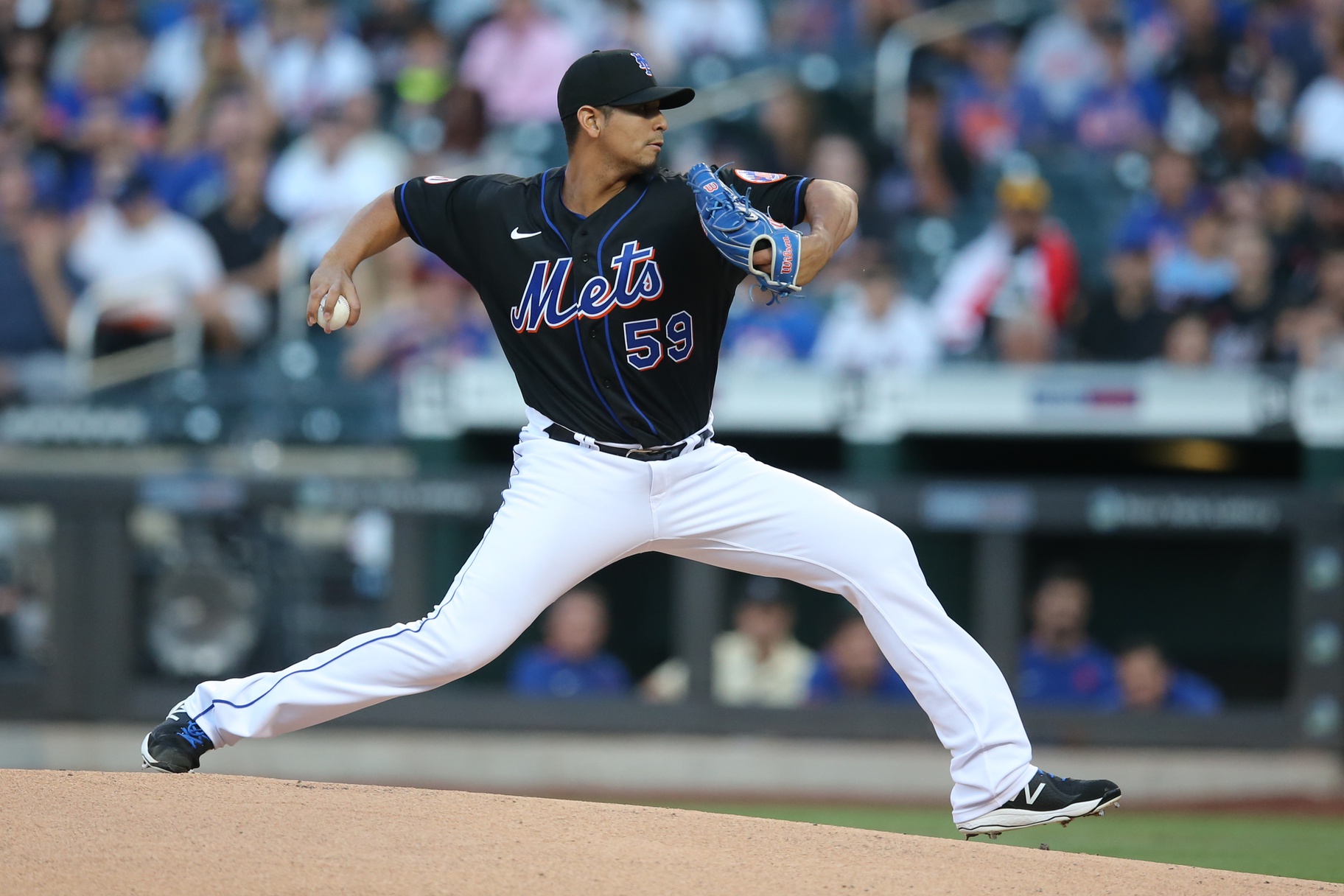
Pitching in front of a full Citi Field crowd, multiple Mets Hall of Famers, and debuting the return of the black jerseys, what could go wrong for Carlos Carrasco last Friday?
Well, his first pitch. Jonathan India took Carrasco’s first pitch all season, a 93.4 mile per hour fastball, deep. Four hundred feet to be exact.
But Carrasco was his usual self. Four innings, one earned run, one walk, and four strikeouts. Still building his pitch count, he was pulled after 58 pitches.
Today Carrasco will make his second start in a Mets uniform, expecting to build upon his first start and pitch deeper against a pesky Marlins team.
Carrasco uses a five-pitch mix. Fastball, sinker, changeup, slider, curveball. Carrasco threw just 19 changeups, 16 sinkers, 15 fastballs, seven sliders, and one curveball against a heavy left-handed Cincinnati lineup.
He peppered his changeup against left-handed hitters. Carrasco flooded lefties down and in on the pitch. He induced nine swings and two misses with it. Four changeups were fouled off and three were put in play, resulting in two outs and a double by Tyler Naquin.
Naquin’s double came during his second at-bat against Carrasco. Carrasco failed to locate his changeup as he did in their first matchup. He left it up and it was crushed 108.1 MPH off the bat.

Carlos Carrasco’s first at-bat against Tyler Naquin

Carlos Carrasco’s second at-bat against Tyler Naquin
During their first matchup, Carrasco’s changeup induced one swing and miss (pitch four) and one foul ball (pitch five).
The 34-year old right-hander loves throwing the change to lefties. In 2020 he threw it 228 times to lefties and 80 times to righties. In 2019, 202 times to left-handers and 35 times to right-handers.
His go-to pitch against right-handed batters is his slider. Out of his seven sliders thrown on Friday, six were against righties.
Carrasco fell in love with his slider during the 2018 and 2019 seasons, throwing it 31.7% and 34.3% of the time, respectively. Clearly his best pitch, his slider had an xBA of .182 in ’18 and .197 in ’19. His usage decreased last season to 28.3% with his changeup usage boosting up nearly 10 points to 28%.
Carrasco induced one swing and miss from the slider on two swings. He threw back-to-back sliders to Kyle Farmer in the first inning. The first made Farmer look silly as it continued to run toward the left-handed batter’s box. The second slider left up in the zone was lined to center field for an out.

Carlos Carrasco’s slider command on Friday
His seven sliders were all over the place but they did avoid the heart of the zone. Ideally, Carrasco wants to place the pitch down and away from right-handed batters as he displayed in 2019.

Carrasco’s 2019 slider locations
Like many pitchers in baseball, Carrasco appears to be a victim of MLBs sticky substance crackdown. His spin rates were significantly lower on Friday from his career averages.
His slider lost 484 rotations, his fastball 322, his lone curveball 315. His sinker lost 297 and his changeup lost the least at 167 rotations. His slider was impacted the most losing five inches of vertical break and three inches of horizontal break during the start.
If it did affect him, Carrasco didn’t let it be known.
“I felt really good, except the first pitch of the game,” Carrasco said. “After that pitch, everything settled down.”
Manager Luis Rojas was impressed with the vet.
“He threw the ball great,” Rojas said. “This guy is an excellent pitcher. He gets jumped the first pitch of the game for that homer, and it didn’t bother him a bit. He fell behind some counts and was able to come back with his repertoire — slider, changeup, the sinker, four-seam. All those things were working.”
The Mets are relying on Carrasco to be the ace of their staff now. Jacob deGrom‘s status remains up in the air, Taijuan Walker is struggling after pitching the most innings since undergoing Tommy John surgery, and Marcus Stroman has been up and down.
Carrasco’s first start wasn’t his prime self. The changeup returned a 16% called strikes and whiffs rate despite being thrown a third of the time and the decreased slider usage was notable. But that wasn’t the expectation in his first major league action since 2020.
He’ll continue to increase his pitch count in Miami and hopefully display more of his repertoire against a right-hand heavy Marlins team.
















